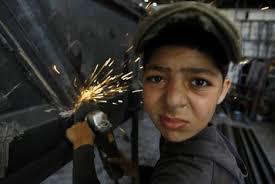
Hazardous child labour is defined by Article 3 (d) of the 1999 International Labour Organisation (ILO) Convention concerning the Elimination of the Worst Forms of Child Labour, No. 182, as: “work which, by its nature or the circumstances in which it is carried out, is likely to harm the health, safety or morals of children.”
Elsewhere, the ILO describes hazardous child labour as “work in dangerous or unhealthy conditions that could result in a child being killed, or injured and/or made ill as a consequence of poor safety and health standards and working arrangements. Some injuries or ill health may result in permanent disability.”
According to the UN Study on Violence Agaisnt Children, “in the case of ‘worst forms’ of child labour, it is not possible to make a distinction between reducing violence and eliminating the working circumstances, since to focus exclusively on violence would imply that children might be left in hazardous and exploitative labour if the violence alone were stopped”.
Hazardous child labour is also described as the largest category of the worst forms of child labour, with an estimated 126 million children aged 5-17 working in dangerous conditions in sectors as diverse as agriculture, mining, construction, manufacturing, service industries, hotels, bars, restaurants, fast food establishments, and domestic service, and is found in both industrialised and developing countries. For example, children engaged in domestic work may be at considerable risk because of the ‘invisible’ nature of the employment. They are at the mercy of the employer and other household members – “Child domestics describe the relationship as often starting well, but later becoming intolerant and abusive”.
Article 32 of the Convention on the Rights of the Child recognises “the right of the child to be protected from economic exploitation and from performing any work that is likely to be hazardous or to interfere with the child’s education, or to be harmful to the child’s health or physical, mental, spiritual, moral or social development.”
Other articles that relate to the exploitation of child labour include article 34(protection from sexual exploitation); article 35 (protection from trafficking); and article 36 (protection against all other forms of exploitation).
Research suggests that the vast majority of children’s work (69 per cent) is in the agricultural sector, followed by 22 per cent in services and nine per cent in industry. The UN Study on Violence Against Children identifies the main reason why children work as poverty.
The Committee on the Rights of the Child has regularly expressed its concern at the inadequate legal frameworks concerning hazardous labour, for example in Saint Lucia, Mozambique and Algeria.
What can be done about it?
The International Labour Organisation has produced a practical guide to eliminating the worst forms of child labour. It lists seven measures by which parliamentarians can contribute to this cause, which include ratifying ILO Conventions Nos. 138 and 182, adopting and enforcing legislation to prohibit the worst forms of child labour, and monitoring and evaluating progress towards the elimination of the worst forms of child labour.
According to the UN Study on Violence Against Children, “in the case where violence is an integral component of the hazardous and exploitative nature of the labour, covered under ILO
Convention No. 182, children should not be in the workplace. Therefore, the principal response will be to enable them to leave it and take up a new course of life, with parental, social and State support. This requires a multipronged approach, including measures to combat poverty, promote education, and enforce labour regulations”.
Source: CRIN
 FR
FR EN
EN AR
AR








